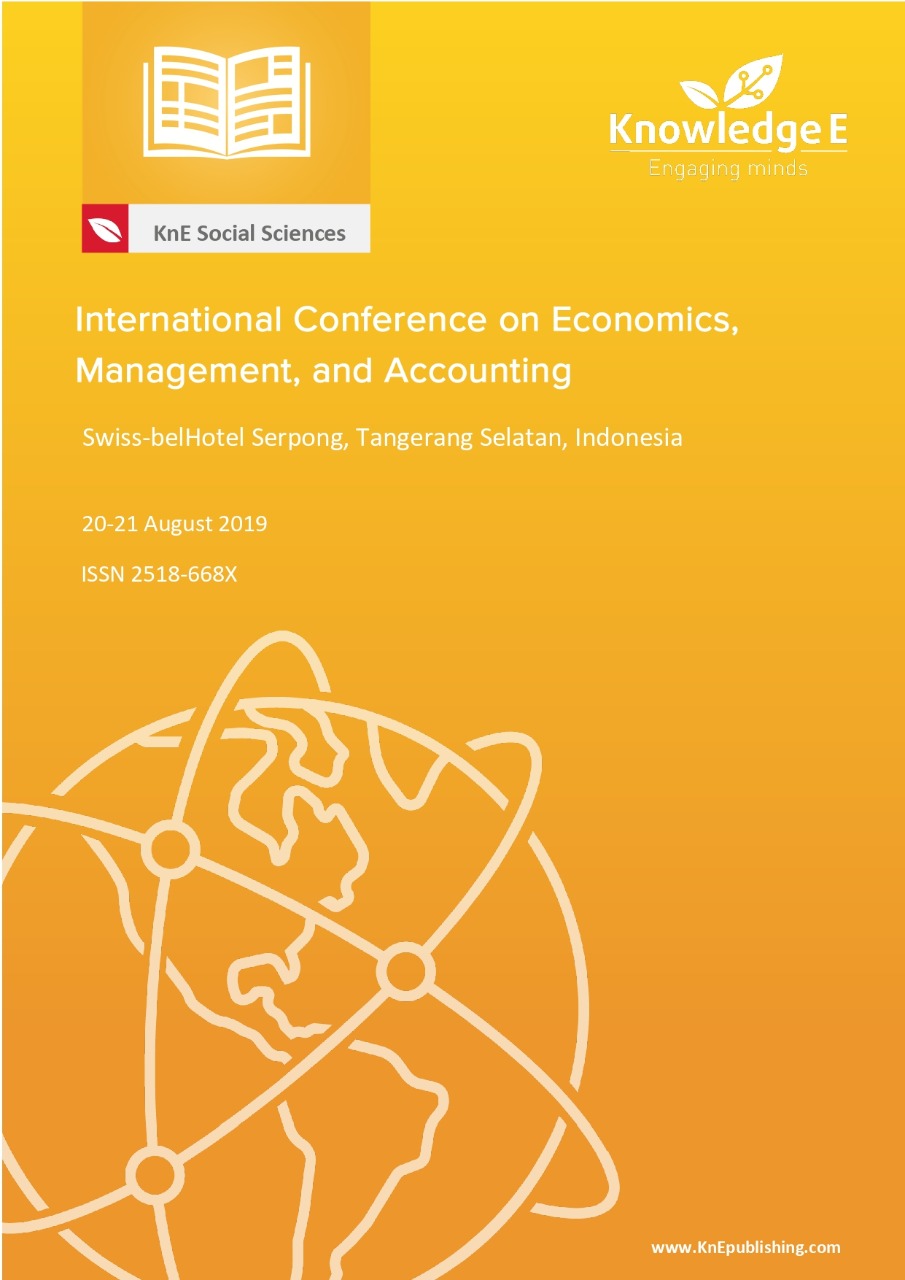Does Audit Quality able to Reduce Cost Stickiness? Evidence from Property, Real Estate and Building Construction Industry
DOI:
https://doi.org/10.18502/kss.v3i26.5401Abstract
The purpose of this study is to determine the level of cost stickiness at SG&A cost (Sales, General, and Administrative) and test whether the level of stickiness costs can be reduced through audit quality. The study sample used property, real estate, and building construction industry listed on the Indonesia Stock Exchange (IDX) for the 2016-2018 period with a purposive sampling technique, so that the final number of samples obtained was 117 sample observations. This study uses eviews version 10 analysis tool. The results of the study show that every 1% increase in net sales will increaseSG&Aby0.610%.Meanwhile,every1%decreaseinnetsaleswillreduceSG&A by (0.610043-0.071380) 0.538%. Furthermore, the research findings show that audit quality can reduce stickiness costs. The implication of this study is that policy makers can use audit quality to reduce stickiness costs.
References
Anderson,M.,Banker,R.,&Janakiraman,S.(2003).AreSelling,general,andAdministrativeCostSticky? Journa of Accounting Research. Vol. 41. Page. 47-63.
Banker,R.D.,Byzalov,D.,&Chen,L.T.(2013).Employmentprotectionlegislation,adjustmentcostsand cross-countrydifferencesincostbehavior.JournalofAccountingandEconomic.Vol.55.Page.111–127.
Becker, C. L., Defond, M. L., Jiambalvo, J., & Subramanyam, K. R. (1998). The effect of audit quality on earnings management. Contemporary Accounting Research. Vol. 15. Page. 1–24.
Cai, C., Huang, Y. J., & Zhao, S. (2005). Empirical research on how audit quality influences earnings management:EvidencefrommanufacturingindustryinShanghai.AuditingResearch.Vol.2.Page.3-10.
Calleja, K., Steliaros, M., & Thomas, D. C. (2006). A note on cost stickiness: Some international comparisons. Management Accounting Research. Vol. 17. Page. 127–140,
Chen,L.,Song,L.,&Shi,D.(2012).Anempiricalstudyontheupwardestimationbiasincoststickiness: Evidence from Chinese listed companies. China Accounting Review. Vol. 1. Page. 3–16.
Cohen, J., Krishnamoorthy, G., & Wright, A. M. (2002). Corporate Governance and the Audit Process. Contemporary Accounting Research. Vol. 19. Page. 573-594.
Dierynck, B., Landsman, W. R., & Renders, A. (2012). Do managerial incentives drive cost behavior? Evidence about the role of the zero earnings benchmark for labor cost behavior in private Belgian firms. The Accounting Review. Vol. 87. Page. 1219–1246.
Fan, J., & Wong, T. J. (2005). Do External Auditors Perform a Corporate Governance Role in Emerging Markets? Evidence from East Asia. Journal of Accounting Research. Vol. 43. Page. 35-71.
Farzaneh N., S.M., Javad, S., Mahdi & B.S.A., Haddad. (2013). A Study of The Stickiness of Cost of Goods Sold and Operating Cost to Changes in Sales Levelin Iran. Studies inBusiness and Economic. Vol. 8.
Francis, J. R., Maydew, E. L., & Sparks, H. C. (1999). The role of big 6 auditors in the credible reporting of accruals. Auditing: A Journal of Practice & Theory. Vol. 18. Page. 17–34.
Gao, Q., & Wu, L. N. (2007). Large shareholder expropriation of funds and the auditor choice: Further evidence. Auditing Research. Vol. 5. Page. 84–90.
Hong, J. M., Xu, Y. D., & Li, Y. R. (2011). Information disclosure quality, controlling shareholder’s embezzlement and auditor selection. Auditing Research. Vol. 2. Page. 107–112.
Jensen, M. C. (1986). Agency costs of free cash flow, corporate finance, and takeovers. The American Economic Review. Vol. 76. Page. 323–329.
Jensen, M. C., &Meckling, W. H. (1976). Theory of the Firms: Managerial Behavior, Agency Costs and Ownership Structure, Journal of Financial Economics. Vol. 3. Page. 305-360.
Jiang,R.,Liu,X.,&Liu,B.(2007).Anempiricalstudyonthegovernanceeffectoftheexteriorauditfrom Chineselistedcompanies:AviewfromCEOturnover.JournalofFinanceandEconomics.Vol.11.Page. 92–103.
Li,W.A.,Wang,X.H.,&Wang,W.(2004).Earningsmanagementandauditopinions:Anempiricalstudy based on non-operating earnings. Journal of Finance and Economics. Vol. 11. Page.126–135.
Liang,S.,Chen,D.,&Hu,X.(2014).ExternalAuditorTypesandtheCostStickinessofListedCompanies. China Journal of Accounting Studies. Vol. 2. Page, 294-322.
Liu,J.H.(2009).Ownership,EarningManagementandAuditOpinions.AuditingResearch.Vol.2.Page. 32-39.
Liu, Q., & Yan, Z. Y. (2006). Accounting Estimates and Quality of Independent Auditing. Accounting Research. Vol. 9. Page. 82-88.
Martania,R.M.,Eltivia,N.,&Setiawan,M.A.(2018).ApakahEarningsManagementMampuMengurangi Tingkat Stickiness Cost? Jurnal Riview Akuntansi dan Keuangan. Vol. 8. Page. 125-134.
Qi, J. N., Chen, H. L., & Zhang, Y. (2004). Auditor size, brand, price and audit quality: Research on chargingandqualityofinternationalbigfourChineseauditmarketing.AuditingResearch.Vol.3.Page. 59–65.
Samryn,L.M.(2012). AkuntansiManajemen: Informasi Biaya untuk Mengendalikan Aktivitas Operasi & Investasi. Jakarta: Kencana
Shleifer,A., &Vishny,R. (1986).Largeshareholdersand corporatecontrol.JournalofPoliticalEconomy. Vol. 94. Page. 461–488.
Stulz,R.M.(1990).Managerialdiscretionandoptimalfinancingpolicies.JournalofFinancialEconomics. Vol. 26. Page. 3–27.
Sun, Z., & Liu, H. (2004). The expense ‘stickiness’ behavior of Chinese listed companies. Economic Research Journal. Vol. 12. Page. 26–34.
Watts, R. L., & Zimmerman, J. L. (1983). Agency Problem, Auditing, and the Theory of the Firm: Some Evidence. Journal of Law and Economics. Vol. 26. Page. 613-633.
Wang,J.C.(2011).Empiricalstudyontheauditindependenceoftopmanagementturnoverinthelisted companies. Journal of Shanxi Finance and Economics University. Vol. 9. Page. 116–124.
Yang,D.M.,Lin,B.,&Wang,Y.C.(2009).Internalcontrol,auditqualityandlargeshareholdertunneling. Auditing Research. Vol. 5. Page. 74–81.
Yue, H. (2006). Large shareholder tunneling and the monitoring role of auditor. China Accounting Review. Vol. 6. Page. 59–68.
Zeng,Y.,&Ye,K.T.(2005).Ownershipstructure,agencycostandexternalauditingdemand.Accounting Research. Vol. 10. Page. 63–70.

